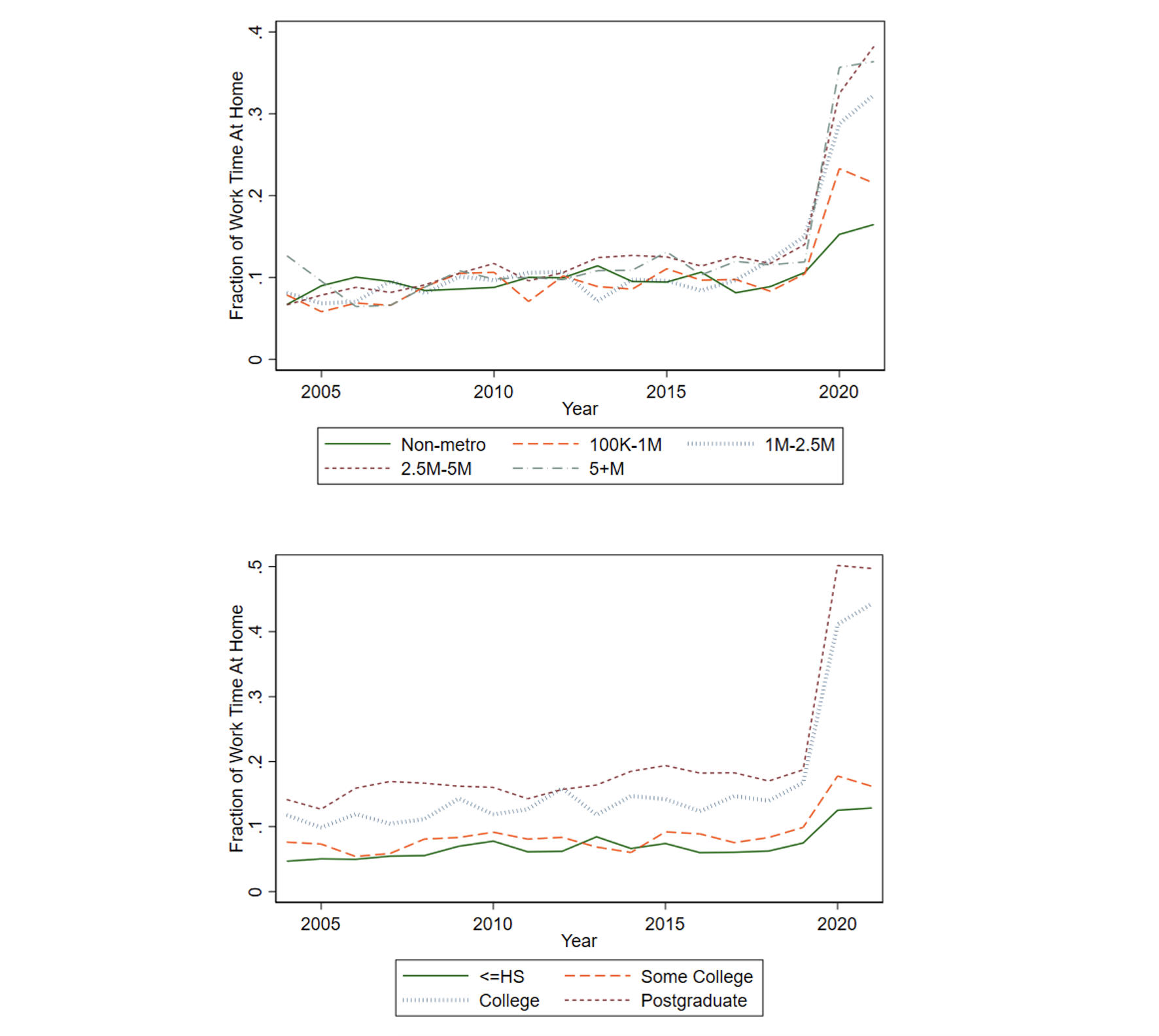Workers earn more in large, dense labour markets. But who earns more, and how much more, has changed considerably over the last half century. In 1970, the share of workers with a college degree was 5 percentage points higher in the densest labour markets than in the least dense ones; by 2015, this gap had increased to 25 percentage points. Over the same period, the gap in hourly wages between workers with and without some college education increased by 30 log points in the densest labour markets but decreased by almost 10 log points in the least dense (Autor 2019). Moreover, the city size premium for non-college workers, which used to be sizeable, is now flat. What is it about large labour markets that allows them to increasingly attract and remunerate highly skilled workers? And are urbanised labour markets likely to retain their distinctive role post-pandemic, as the economy is transformed by a work-from-home revolution?
Economists have offered three related explanations for why work is different in larger labour markets. First, density and size permit lower-cost face-to-face meetings among a wider variety of individuals and thus facilitate knowledge flows across workers (Storper and Venables 2004, Arzaghi and Henerson 2008). Second, the development and adoption of new technologies is concentrated in cities (Carlino et al. 2007, Bloom et al. 2021). And third, the greater pool of demand afforded by larger labour markets allows workers to better specialise, leading to productivity and thus wage gains (Becker and Murphy 1992).
In a recent research article, we explore these three hypotheses and provide a detailed characterization of the way in which work differs in large versus small labour markets (Atalay et al. 2022). Drawing on the raw text of 7.2 million job ads posted online by employers between 2012 and 2017, we extract measures of work content separately by worker education, geography, occupation, and firm. Relative to existing work, our approach uses the full text content of each advert and has three key advantages.
First, existing datasets (e.g. O*NET) cannot directly measure how jobs within the same occupation vary across geography. The job ad text allows us to measure how, for example, financial analysts in New York City perform different work activities compared to those in Ann Arbor, Michigan or Hastings, Nebraska. Second, since we have access to the raw text that employers write and job seekers observe, we use tools from natural processing to measure job tasks at a granular level – as verb-noun pairs that appear in the ads. Finally, because of the high resolution at which we can measure job tasks, we can compute how specialised jobs are – i.e. how much variation there is among jobs within a given market-by-occupation (or firm-by-market) pair. This approach is particularly useful for measuring worker specialization in tasks, which has been approximated in prior work counting the number of distinct occupations or job titles, but has never been measured directly using the task content of jobs.
Work is different in large labour markets
We show that jobs are fundamentally different in larger labour markets. There, work involves more interactive tasks, new technology adoption, and is more specialized. Figure 1 depicts the gradients of these three job characteristics, comparing labour markets of various population deciles. Relative to ads posted in the smallest labour markets, job ads posted in the largest decile labour markets have one-and-a-half times as many mentions of new technologies and 0.2 standard deviations more mentions of non-routine interactive tasks. The increased intensity of interactive tasks and new technology adoption in cities is almost exclusively a phenomenon among jobs requiring a college degree. While differences in the mix of occupations are certainly important for explaining differences in task content across labour markets, approximately 10% of the technology gradients and 30% of the interactive task gradients are due to differences that exist within occupations. Finally, jobs in larger markets are more specialised. Within occupations and within firms, the overlap in tasks across job ads is less in larger labour markets. As one would expect if market size drove specialization, the firm-specialization gradient is stronger in non-tradable sectors.
Figure 1 Tasks, technologies, and worker specialisation
Notes: The top left panel above plots coefficients from a job ad-level regression of non-routine interactive task intensity on CZ size deciles, with and without controlling for six-digit occupation fixed effects. The top right panel plots the analogous coefficients from a job-ad level regression of new technologies requirements listed in the job ad. The bottom panel plots the analogous coefficients from a firm-CZ level regression of the mean task-dissimilarity on CZ population size deciles, weighted by the number of ads in the cell, separately by tradable and non-tradable industries. See Atalay et al. (2022) for details.
What are the implications of these differences in work practices for the wages that workers earn in large and small labour markets? To address this question, we estimate a regression comparing wages in each occupation by labour market (as measured in the American Community Survey) to our job ad-based measures of workers’ specialisation, interactive task intensity, and new technology adoption. Because this regression includes occupation indicators, it highlights the variation that is uniquely measured in our new dataset. Our estimates imply that these three measures explain approximately one-fifth of the 30 log point difference in wages among workers between the largest and smallest labour markets. Following Combes and Gobillon (2015), we can also measure the task intensity as an elasticity with respect to labour market population. The elasticity of technological content is about 0.05 and that of interactive tasks is 0.17. After including SOC fixed effects, about 16% and 29% of the elasticities remain. For firm specialisation, the elasticity with respect to population is around 0.17.
A granular view
In addition, measuring tasks directly from the raw text affords us the opportunity to study jobs along dimensions that were not previously observed. In particular, what exactly are the tasks that vary across markets, and how does task content vary with college attainment? Whether we control for occupation fixed effects or not, we find that tasks related to written communication, project management (e.g. “prioritize tasks”, “meet deadlines”), and interpersonal relationships (e.g. “maintaining relationships”, “providing coaching”) are among the ones with the steepest positive gradients, while those related to customer service and retail sales (e.g. “maintain store”, “provide customer service”, “greet customers”) tend to have the steepest negative gradients. In addition, essentially all technologies are mentioned more frequently in larger labour markets, and there are notable differences by the education requirement of the job : “GIS” and “Python” are among the technologies with the steepest gradient for jobs requiring a college degree, while “Excel” and “Outlook” tend to have the steepest gradient for jobs requiring only a high school diploma. These results show that jobs in large markets require specific technology investments.
The future of work in cities
Will large labour markets retain these distinct qualities into the future? Conjecture abounds over the consequences of the work-from-home revolution on urban labour markets (Barrero et al. 2021, Davis et al. 2021). As a first glimpse into the future of working-from-home, the top panel of Figure 2 plots the share of individuals’ work time that takes place at home. We draw on the American Time Use Survey, a survey conducted by the Bureau of Labor Statistics, to study how individuals are spending their time. Prior to the pandemic, there was little difference between small and large metropolitan areas in the extent to which individuals worked from home. However, during the pandemic period, the share of work time conducted at home was 20 percentage points higher in the largest metropolitan areas compared to non-urban environments. Perhaps strikingly, the take up in work from home has been most pronounced for highly educated workers, as shown in the bottom panel of Figure 2. While part of the spike in working from home in cities during 2020-2021 may be due to the elevated risk of Covid-19 transmission in cities, recent research has shown that working from home has persisted in the post pandemic period (Aksoy et al. 2022).
Figure 2 Working from home
Notes: The source for both panels is the 2004 to 2021 American Time Use Survey, including only work activities (those with a code beginning with “0501”) performed by individuals who are at least 18 years old. We compute the (ATUS-sample-weighted average) fraction of work time that takes place at home: either the respondent’s own home or someone else’s home. The top panel groups observations according to the population of the MSA in which the respondent resides; the bottom panel groups observations according to the individual’s educational attainment.
At first glance, it appears as if new work-from-home technologies, by reducing the need for workers to be in the same location to interact with one another, may diminish one of the key advantages that urban labour markets have. A second possibility is that work-from-home technologies – like most technologies – tend to be adopted first and more intensely by more educated workers and by workers in larger labour markets. Yet another interpretation is that there are subtle differences among interactive tasks. While college-educated workers work in interaction-intensive jobs, it could be that their interactions are more amenable to remote work (e.g. planning a marketing strategy versus manning a retail store). Which interpretation is correct and what does this all mean for the future of work in cities? Time will tell.
References
Aksoy, C G, J M Barrero, N Bloom, S Davis, M Dolls, and P Zarate (2022), “Working from Home Around the World”, VoxEU.org, 8 October.
Atalay, E, D Tannenbaum, and S Sotelo (2022), “The Geography of Job Tasks.” Working Paper.
Autor, D (2019), "Work of the Past, Work of the Future", AEA Papers and Proceedings 109: 1-32.
Arzaghi, M and J V Henderson (2008), “Networking off Madison Avenue”, The Review of Economic Studies 75(4): 1011–1038
Barrero, J M, N Bloom, and S Davis (2021), “Let Me Work from Home, Or I will Find Another Job”, VoxEu.org, 27 July.
Becker, G and K Murphy (1992), “The Division of Labor, Coordination Costs, and Knowledge”, Quarterly Journal of Economics 107(4): 1137-1160.
Bloom, N, T Hassan, A Kalyani, J Lerner, and A Tahoun (2021), “How Disruptive Technologies Diffuse”, VoxEU.org, 10 August.
Carlino, G, S Chatterjee, and R Hunt (2007), “Urban Density and the Rate of Invention”, Journal of Urban Economics 61(3): 389–419.
Combes, P-P and L Gobillon (2015), “The Empirics of Agglomeration Economies”, in G Duranton, J V Henderson and W C and Strange (eds), Handbook of Regional and Urban Economics, Vol. 5, Elsevier.
Davis, M, A Ghent, and J Gregory (2021), “The Work-from-Home Technology Boon”, VoxEU.org, 18 April.
Storper, M and A J Venables (2004), “Buzz: Face-to-Face Contact and the Urban Economy”, Journal of Economic Geography 4(4): 351–370.








